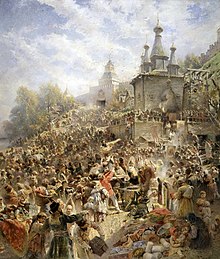Monument to Minin and Pozharsky, Nizhny Novgorod
Памятник Минину и Пожарскому | |
 Monument to Minin and Pozharsky against the backdrop of the Kremlin and the Church of St. John the Baptist | |
 | |
| 56°19′47″N 43°59′49″E / 56.329861°N 43.996920°E | |
| Location | National Unity Square, Nizhny Novgorod, Russia |
|---|---|
| Designer | Ivan Martos |
| Builder | Zurab Tsereteli |
| Material | bronze |
| Beginning date | 2004 |
| Completion date | 2005 |
| Opening date | November 4, 2005 |
The Monument to Minin and Pozharsky (Russian: Па́мятник Ми́нину и Пожа́рскому) is a copy of the monument erected on Red Square in Moscow. The monument is located in the historic centre of Nizhny Novgorod on National Unity Square, under the walls of the Kremlin, near the Church of St. John the Baptist.
History of creation[edit]

The history of the monument goes back to the Time of Troubles. Russia was under a Polish-Lithuanian siege, and Moscow was occupied by the Poles.[1] Then, in 1611, in Nizhny Novgorod, the zemstvo elder Kuzma Minin began to call on the people to take up arms against the Polish occupiers. He was supported by the city council, governors and the clergy. At the ringing of the bell, the people gathered in the Kremlin, in the Transfiguration Cathedral.[2] After the service, Minin appealed to the people of Nizhny Novgorod with a call to stand up for the liberation of the Russian Tsardom from foreign enemies. Then it was decided to raise funds for the people's militia.[3]
It was also necessary to find a commander for the future militia. Nizhny Novgorod decided to ask Prince Dmitry Pozharsky to head it.[2] The noble prince did not immediately agree and set the condition that Minin was in charge of economic affairs in the militia.


In 1803, it was decided to start raising funds for the erection of a monument in honor of Minin and Pozharsky. Ivan Martos immediately got down to business.[4] Initially, it was supposed to erect a monument in Nizhny Novgorod, but due to the fact that it was of great value to the country, it was decided to install it on Red Square in Moscow. 4 March [O.S. 20 February] 1818 the unveiling ceremony took place.[5] In Nizhny Novgorod, on the territory of the Kremlin, in 1828, an obelisk was erected in honor of Minin and Pozharsky instead of the monument.[6] In the 1910s, it was planned to erect a new monument to Minin and Pozharsky in the city, but due to the beginning of the revolutionary events, they did not manage to complete it, and from the material prepared for the memorial, the Bolsheviks made a monument to the Victims of the Revolution of 1905, which was installed on Freedom Square (Russian: Площадь Свободы, romanized: Ploshchad' Svobody).[7]
In 2004, Moscow Mayor Yury Luzhkov decided to install a copy of the Moscow monument in Nizhny Novgorod. He offered to copy the monument to the famous Russian sculptor Zurab Tsereteli.[8][9] On November 4, 2005, the grand opening of the monument took place on the new square of Nizhny Novgorod - the National Unity Square.[10] The choice of the place was not accidental - after all, it was from here that the people's militia of 1611 began.[11]
On this day, a new holiday appeared in Russia - the day of unity. The date also turned out to be not accidental, because on October 22 (November 4), 1612, Moscow was liberated from the Poles, and in 1649 Tsar Alexis ordered to celebrate the day of the Our Lady of Kazan, which is now also celebrated on November 4.[9]
Differences of monuments[edit]
- The monument, which stands in Nizhny Novgorod, is 5 cm smaller than the original.
- The inscriptions on the pedestals differ:

See also[edit]
References[edit]
- ^ "Томаш Бохун. История польского гарнизона в Москве. 1610 — 1612 гг". www.historia.ru (in Russian). Retrieved 2023-04-24.
- ^ a b "Kuzma Minin and Dmitry Pozharsky". Presidential Library. Retrieved 2023-04-24.
- ^ "Imperiia: The Butcher who Saved Russia: Minin's Appeal". Imperiia: a spatial history of the Russian Empire. Retrieved 2023-04-24.
- ^ "Art@Site Ivan Martos, Kuzma Minin and Prince Dmitry Pozharsky, Moscow". www.artatsite.com. Retrieved 2023-04-24.
- ^ "НЭБ – Национальная электронная библиотека". rusneb.ru – Национальная электронная библиотека (in Russian). Retrieved 2023-04-24.
- ^ Volodina, Svetlana (2006). "Памятник Минину и Пожарскому в Нижнем Новгороде". Диалог искусств: журнал Московского музея современного искусства. 1: 14–15. ISSN 1812-304X.
- ^ "Памятник жертвам революции 1905 года :: Капризы памяти". baza.vgd.ru (in Russian). Retrieved 2023-04-24.
- ^ "Зураб Церетели изваяет римейк памятника Минину и Пожарскому" (in Russian). Archived from the original on 2014-10-23. Retrieved 2014-10-13.
- ^ a b Новости, Р. И. А. (2005-10-31). "4 ноября в Нижнем Новгороде будет открыт памятник Минину и Пожарскому". RIA Novosti (in Russian). Retrieved 2023-04-24.
- ^ "Торжественная церемония открытия памятника Минину и Пожарскому в Нижнем Новгороде". www.rah.ru (in Russian). Retrieved 2023-04-24.
- ^ "Второе ополчение 1611–1612. Большая российская энциклопедия". Большая российская энциклопедия (in Russian). Retrieved 2023-04-24.


